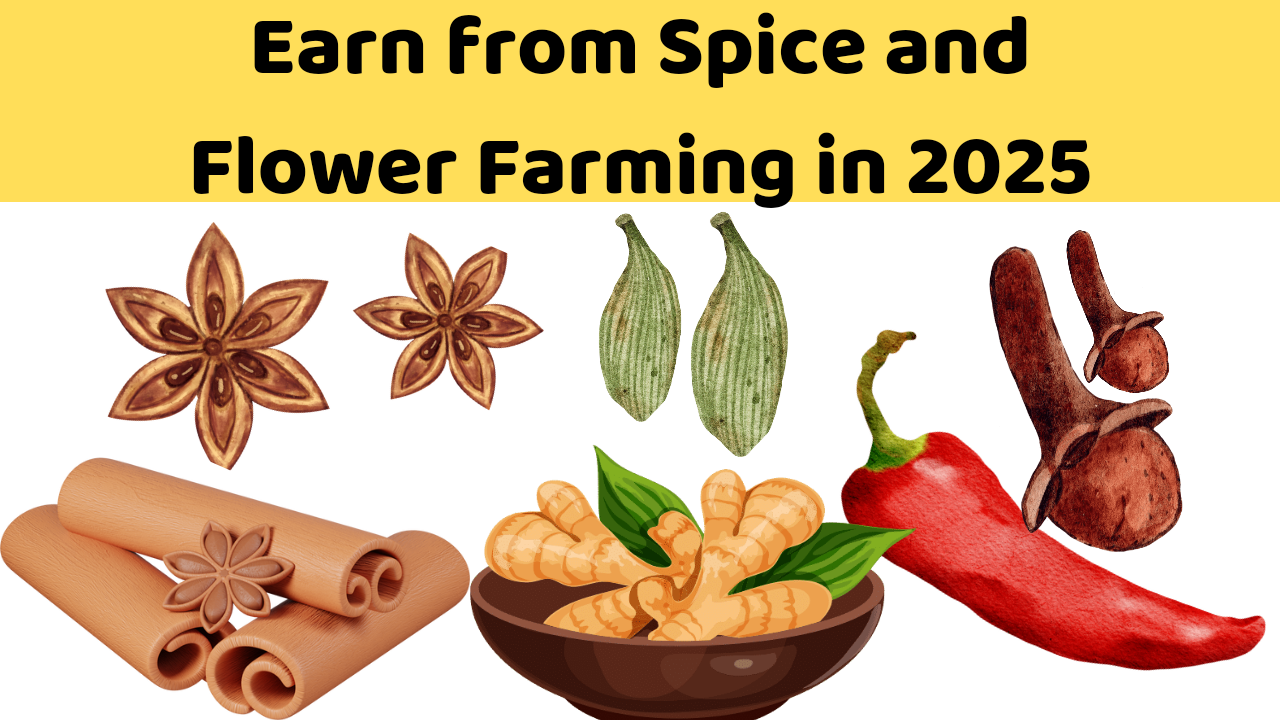Earn from Spice and Flower Farming in 2025: A Comprehensive Guide for Farmers.
Why Spice and Flower Farming?
Why Spice and Flower Farming and how it will impact the farming and income we will get to know through Earn from Spice and Flower Farming in 2025.
1. High-Demand Crops Both spices and flowers are high-demand crops with consistent market value and Earn from Spice and Flower Farming in 2025. Spices like turmeric, ginger, cardamom, and chilies are essential ingredients in many cuisines worldwide, making their demand evergreen. Likewise, flowers, especially those used for decorative and ceremonial purposes (like roses, marigolds, and orchids), are always in demand for weddings, festivals, and other special events.
2. Higher Profit Margins: Earn from Spice and Flower Farming in 2025. Compared to staple crops like wheat or rice, spices, and flowers offer higher profit margins and Earn from Spice and Flower Farming in 2025. The input costs for growing spices and flowers are relatively low, but their selling prices in local, national, and international markets are significantly higher. This allows farmers to earn a substantial return on investment (ROI) with proper planning and management.
3. Crop Diversification: Earn from Spice and Flower Farming in 2025, Growing spices and flowers helps farmers diversify their crop portfolio, which reduces the risk associated with growing a single crop. In times of uncertain weather conditions or fluctuating market demands, having a variety of crops helps stabilize income.
4. Support from Government Subsidies Many governments are encouraging farmers to switch to or include high-value crops like spices and flowers in their farming practices. As part of agricultural reforms, subsidies are provided to help cover the cost of seeds, fertilizers, and even modern irrigation techniques. Farmers who take advantage of these subsidies can significantly reduce their initial costs and maximize their profits.
Earn from Spice and Flower Farming in 2025: Benefits of Spice Farming
1. Low Investment, High Returns Spice farming, especially for crops like turmeric, ginger, and black pepper, requires relatively low initial investment compared to traditional grain crops. The demand for organic spices, in particular, is surging globally, opening up more opportunities for farmers to cater to export markets. Since spices are high-value products, they bring in good returns per kilogram.
2. Growing International Market With the rise of spices in health and wellness industries (such as turmeric being used for its anti-inflammatory properties), the international market for these products is expanding rapidly. This growing global demand ensures that spice farmers are not only catering to local markets but also have the opportunity to export their products for even higher prices.
3. Ease of Cultivation Spices like coriander, cumin, and fenugreek require minimal maintenance and can be cultivated in smaller areas, making them ideal for small-scale farmers. They thrive in various climates and soil types, and since many spices have a long shelf life, they can be stored and sold as market conditions improve.
4. Diverse Varieties Farmers can explore different varieties of spices that suit their regional climate and soil conditions. For example, chilies and black pepper grow well in tropical regions, while cumin and fennel thrive in drier climates. This adaptability provides farmers with more flexibility and ensures better yields in different geographical locations.
Earn from Spice and Flower Farming in 2025: Advantages of Flower Farming
1. High Demand, Especially in Festive Seasons Flowers are always in demand, but their demand skyrockets during festive seasons, weddings, and religious ceremonies. Flowers like marigolds, roses, and lilies are widely used for decoration and offerings, making them a profitable venture for farmers, especially during peak seasons. Selling flowers in local markets or tying up with flower vendors ensures a consistent source of income.
2. Year-Round Income Unlike many seasonal crops, flowers can be grown year-round, provided they are planted in suitable climates and conditions. This ensures a continuous flow of income for farmers, reducing financial gaps between harvests. For instance, roses and marigolds can be grown almost throughout the year, while seasonal flowers like chrysanthemums and orchids can be grown during specific times for maximum profitability.
3. Low-Cost Cultivation with High Yields Flowers require minimal input in terms of land and fertilizer, yet they yield high returns. Many flowers grow well in marginal soils with proper irrigation, making them a low-cost investment for farmers. With the right market strategy, flower farmers can expect quick returns within a short period.
4. Opportunities for Value Addition Farmers can also explore value-added products like essential oils, perfumes, or dried flowers, which sell at a premium in the global market. This diversification opens up additional revenue streams and adds to the profitability of flower farming.
Earn from Spice and Flower Farming in 2025: Steps to Start Spice and Flower Farming
In this article, we will explore an opportunity to Earn from Spice and Flower Farming in 2025 and how it is profitable for farming and farmers too.
1. Choose the Right Crop: Earn from Spice and Flower Farming in 2025. Before beginning, assess your land, climate, and soil type to decide which spices or flowers will thrive best in your region. Research the market demand for different crops in your area or even beyond to choose the most profitable ones.
- For Spice Farming: Turmeric, ginger, chilies, cardamom, black pepper.
- For Flower Farming: Roses, marigolds, lilies, chrysanthemums, and orchids.
2. Land Preparation and Sowing Prepare the land based on the specific requirements of the chosen crop. Spices like ginger and turmeric need well-drained soil with organic matter, while flowers like roses need nutrient-rich soil with proper irrigation.
3. Utilize Subsidies Check with local agricultural authorities or your country’s agriculture ministry for subsidies related to spice and flower farming. These might cover the cost of seeds, fertilizers, and even machinery or drip irrigation systems, reducing your initial investment.
4. Adopt Modern Farming Techniques Invest in modern farming practices like drip irrigation, organic fertilizers, and integrated pest management to maximize crop yield and quality. Greenhouses and playhouses can be used for flower cultivation to regulate temperature and ensure year-round production.
5. Post-Harvest Management Proper post-harvest management, such as drying, grading, and packaging of spices, is crucial to maintaining product quality. Flowers need to be harvested at the right time and stored in cool, shaded areas to prevent wilting.
6. Market Linkages Form strong linkages with local traders, supermarkets, or export agencies to ensure a smooth sales process. Many cooperatives and farmer organizations assist in marketing and selling these high-value crops both locally and internationally.
How to Maximize Profits in Spice and Flower Farming
- Focus on Organic Farming: As global demand for organic products rises, switching to organic spice and flower farming can fetch higher prices. Organic farming also improves soil health and reduces long-term costs.
- Export Markets: Once established locally, farmers can explore exporting spices to international markets, where the demand is robust, and prices are higher. Likewise, flowers, especially exotic varieties, can be exported to countries with colder climates where they are not readily available.
- Collaborate with Florists and Spice Manufacturers: Tying up with florists, wedding planners, and spice manufacturers can guarantee regular sales and better prices. Additionally, selling directly through farmer markets or online platforms can eliminate middlemen, further boosting profits.
- Value Addition: Consider venturing into value-added products like essential oils, dried flower arrangements, or ground spices to tap into a niche market. These products often sell at premium prices, significantly boosting profitability.
Key Points to Remember
Earn from Spice and Flower Farming in 2025 recommended and Spice and Flower Farming offers farmers an exciting opportunity to diversify their income, earn higher profits, and take advantage of growing market demand both locally and globally. In Earn from Spice and Flower Farming in 2025 With minimal initial investment and the availability of government subsidies, the potential for success is immense. By adopting modern farming techniques, focusing on high-demand crops, and building strong market linkages, farmers can earn big from spice and flower farming and secure a sustainable and profitable future.
FAQs
Q1: How can farmers increase their income through spice and flower farming?
Ans: Farmers can increase their income by cultivating high-value crops like spices (turmeric, ginger, chilies) and flowers (roses, marigolds, orchids). These crops have a high market demand locally and internationally, and they typically yield better profits than traditional grains. Government subsidies for seeds, fertilizers, and irrigation also help reduce input costs and improve overall profitability.
Q2: What are the government subsidies available for spice and flower farming in 2025?
Ans: In 2025, various government schemes offer subsidies for spice and flower farming. These include financial assistance for purchasing seeds, fertilizers, and modern irrigation systems. Farmers can also receive subsidies for greenhouse farming and organic practices. These subsidies aim to reduce the initial investment and make farming more profitable.
Q3: What are the challenges farmers face when growing spices and flowers?
Ans: Although spice and flower farming offers high profits, farmers face challenges such as fluctuating market prices, unpredictable weather conditions, and pest infestations. High labor costs and the need for skilled workers for certain crops can also affect profitability. However, with modern farming techniques and proper planning, these risks can be mitigated.
Q4: Is spice and flower farming sustainable for small-scale farmers?
Ans: Yes, spice and flower farming can be highly sustainable for small-scale farmers, especially when they adopt organic farming practices and make use of government subsidies. These crops require relatively small areas of land but yield high returns, making them ideal for farmers with limited resources. Additionally, crop diversification can help small farmers reduce risk and ensure stable income.
Q5: What are the best-selling spices and flowers in 2025?
Ans: In 2025, the best-selling spices include turmeric, ginger, chilies, and black pepper due to their growing use in culinary and medicinal applications. Among flowers, marigolds, roses, orchids, and lilies remain popular for festivals, weddings, and exports. Demand for organic spices and exotic flowers is also on the rise, offering farmers the opportunity to cater to premium markets.
Q6: How can farmers market their spice and flower crops for better profits?
Ans: Farmers can market their spice and flower crops through local wholesale markets, farmer cooperatives, or direct-to-consumer sales at farmer’s markets. Additionally, farmers can explore partnerships with exporters or use e-commerce platforms to sell directly to global buyers. Branding their produce as organic or high-quality can also attract premium prices.
Q7: What are the benefits of crop diversification with spices, flowers, and vegetables?
Ans: Crop diversification helps farmers mitigate risks by not depending on a single crop for their income. Growing a combination of spices, flowers, and vegetables ensures that farmers can harvest and sell throughout the year. This strategy also improves soil health and reduces the risk of crop failure due to pests or adverse weather conditions.
Q8: What modern techniques can help boost spice and flower yields?
Ans: Farmers can boost their spice and flower yields by using modern techniques like drip irrigation, greenhouse farming, organic fertilizers, and integrated pest management. Greenhouses provide a controlled environment for flower cultivation, while drip irrigation ensures optimal water usage for spice crops. These methods enhance productivity while reducing water and fertilizer consumption.
These Degrees in Agriculture Can Make You Rich
लेबनान और सीरिया में पेजर ब्लास्ट, कैसे कम्युनिकेशन डिवाइस बन जाते हैं घातक बम?


Your blog is a testament to your dedication to your craft. Your commitment to excellence is evident in every aspect of your writing. Thank you for being such a positive influence in the online community.